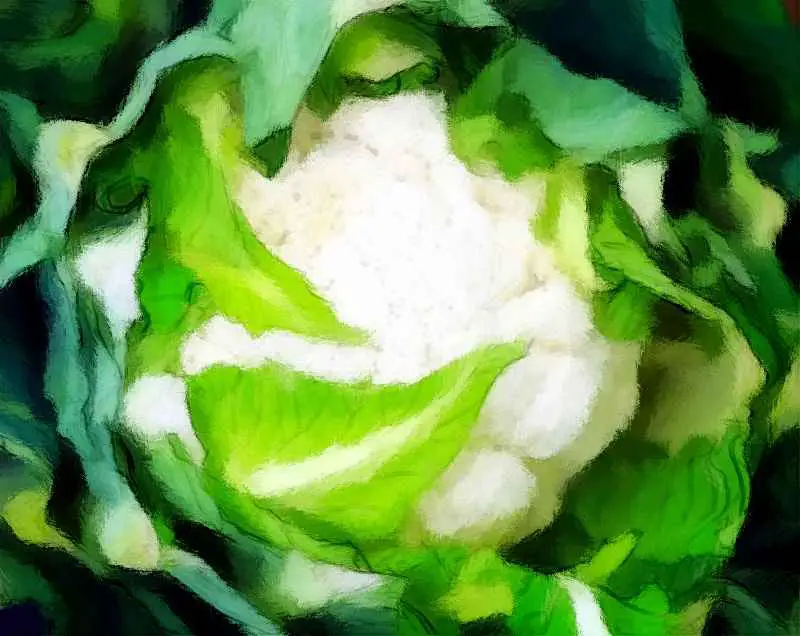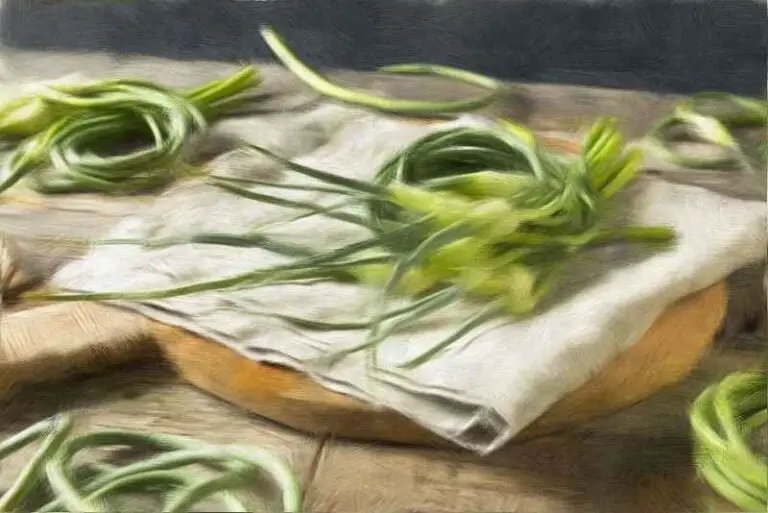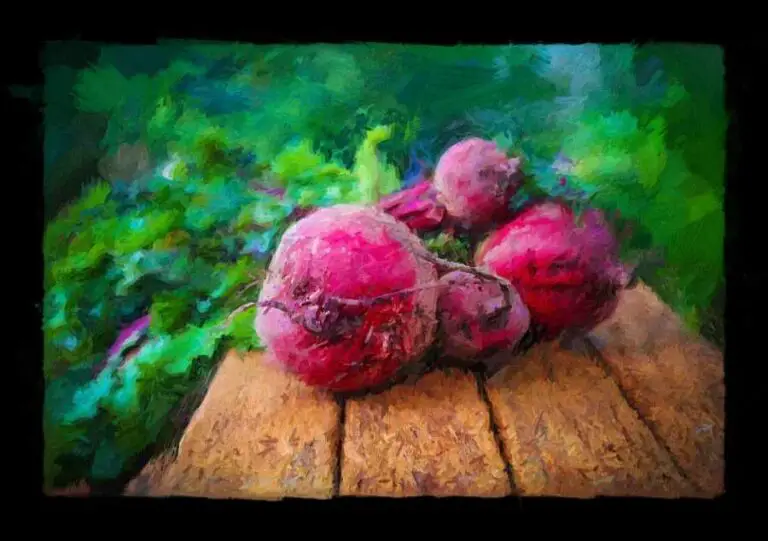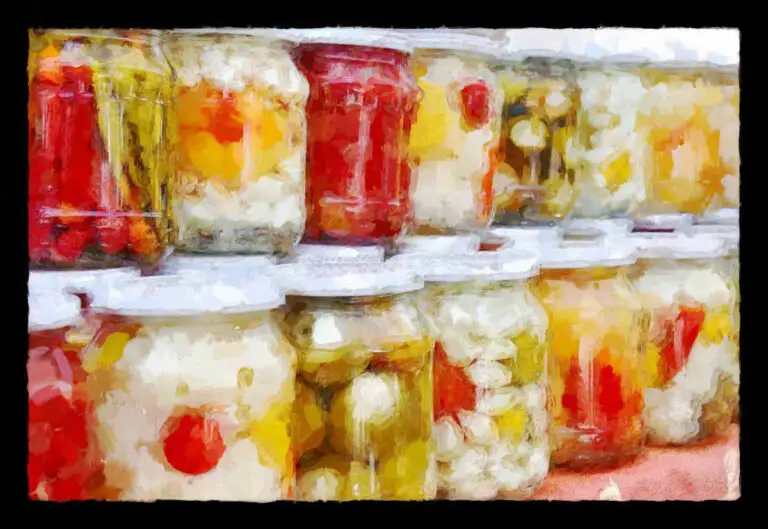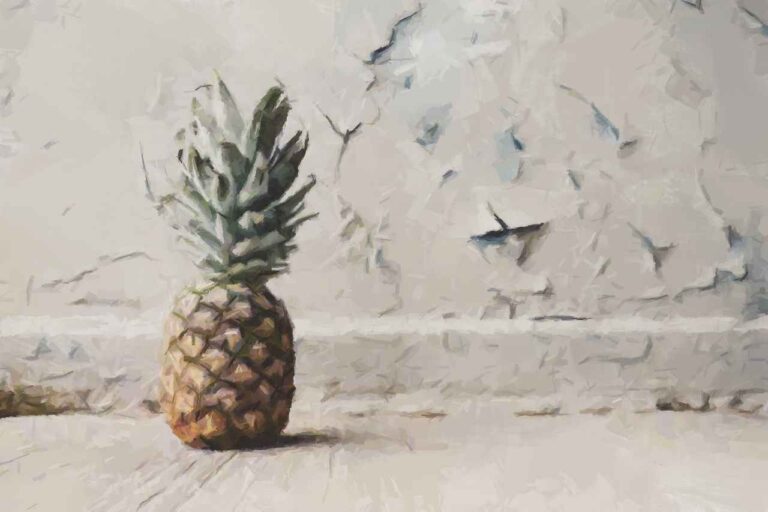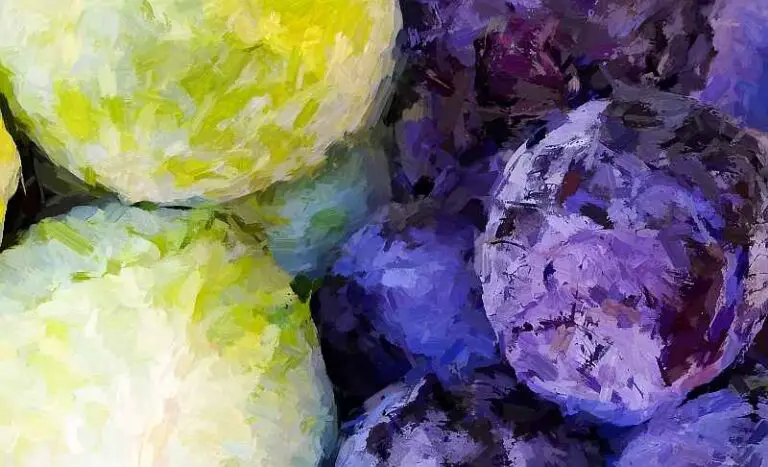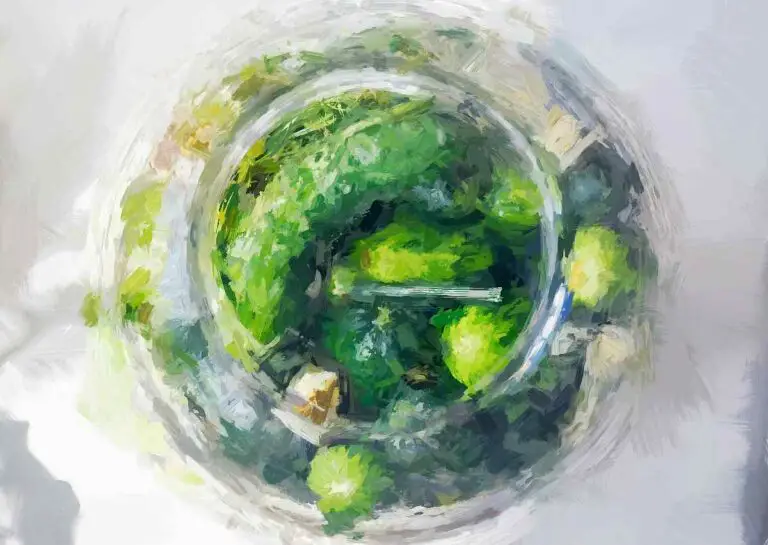Fermented Cauliflower Leaves And Stems
With these four delicious zero waste recipes you will no longer throw cauliflowers leaves or stems ( aka money ) in the bin.
I have been told that every time you prepare some cauliflower you throw away leaves and stems, is it true?
If my source is reliable and you have been, I promise you that after reading this article you will never do that again.
The reasons are very simple.
BTW If you are looking for recipes to ferment cauliflower heads you can find them here.
The first one is money.
I am confident you too have noticed that when you buy a cauliflower, and often pay dearly for it, you simply end up throwing half the money you paid in the rubbish bin.
Literally.
And the same is true also if you grow the caulies: what you throw away and don’t use to feed the family has to be replaced by something bought from the store
The second reason is the nutritional value of
cauliflower leaves and stems.
Let me just quickly give you a couple of facts
Proteins: Cauliflower leaves contain more than twice the amount of protein compared to cauliflower.
Fats: Cauliflower leaves provide more than three times the fat content compared to cauliflower.
Calories: Cauliflower leaves supply double the calories compared to cauliflower.
Calcium: Cauliflower leaves are an exceptional source of calcium, providing 19 times more than cauliflower.
Phosphorus: Cauliflower leaves offer almost double the amount of phosphorus compared to cauliflower.
Iron: Cauliflower leaves are a very rich source of iron, providing 32 times more than cauliflower.
That’s right.
Throwing away cauliflower leaves and stems often means throwing away the most nutritional part of the plant.
SO HERE WE COME TO THE RESCUE!
Whilst there are out there ( on the web… ) many very good recipes that use leaves and stems in every sort of way, I have found none that teaches how to ferment them.
And as we often ferment them very successfully we are happy to share what we know.
The Recipes You’ll Learn
I will give you the 4 recipes we use the most:
- One to ferment the whole leaf
- One to ferment only the green part ( suitable for big leaves )
- One to ferment thin and soft stems
- One to ferment big stems
If you are ready I’d dive right in.
HEADS UP: Before starting, if you have not done it yet, I recommend you read these blog posts; they will be very helpful.
- How To Make A Fermentation Brine
- How To Properly Airlock A Jar
- 30 Most Asked Questions About Fermentation
Cauliflower Leaves Kimchi
As anticipated, this recipe is designed to ferment the entire leaf but, for better results, it’s best to only use only those with a fairly tender stem.
If you only have large leaves with large stems you could try to make it work by cutting leaf and stem longitudinally into smaller sections.
Quantity wise, this recipe will work perfectly as is for a 1kg / 1qrt tightly packed jar.
INGREDIENTS
- cauliflower leaves ( with stems )
- 3 medium sized carrots
- 2 small radishes
- 3-4 green onions
- 1 tablespoon of Korean gochugaru or any other chilli type you like
- 1 tablespoon grated ginger
- 3-4 cloves garlic, minced
- 2 tablespoons fish sauce (or soy sauce for a vegetarian version)
- 1 ½ tablespoons of coarse sea salt ( 20-25 grams ) + ½ cup more
- 1 teaspoon salt (5 grams)
- 1 tablespoon sesame oil (15 millilitres)
STEPS
- Clean, wash and trim the cauliflower leaves, removing all imperfections and those stems that are just to hard to eat
- Depending on your preference leave them in big pieces ( even whole if you like ) or cut them into bite-sized pieces
- Cover the bottom of a deep tray with one layer of leaves and sprinkle some salt on each one ( use the extra half cup of salt for this )
- Continue by layering leaves sprinkled in salt until you run out.
- Let them sit until the stem have become more flexible or even bendable ( this is why we use the type of leaves I explained above )
- Wash carrots, radishes and green onions then proceed with julienning the carrots, slicing the radishes and chopping the green onions
- In a large bowl, combine red pepper flakes, grated ginger, minced garlic, fish sauce (or soy sauce for a vegetarian version), sugar, salt, and sesame oil. Mix well to form a smooth, well mixed paste.
→ If the paste is too thick add a little water
- Remove the cauliflower leaves from their salty bed and wash them
- To the same large bowl add cauliflower leaves, julienned carrot and chopped green onions then WITH GLOVES mix everything thoroughly until all leaves are well-coated with the paste
- Now it’s time to tightly pack the jars with your kimchi mixture
- Make sure to press down the produce enough to eliminate air pockets and to leave enough head space ( 3cm / 1 inch )
- Seal the jars and let them ferment at room temperature for anything between 5 days and two weeks depending on your taste preferences
- When your cauliflower leaves kimchi has reached a flavour you like it’s time to move it to the refrigerator for storage
Now, as not everyone is a declared fan of fish sauce, and even those who love it might have a hard time finding anything that is good quality, I will give you a recipe variation.
This recipe variation uses oiled preserved anchovy fillets which, as the name suggests, are anchovy fillets that have been salted first then cleaned and preserved in oil.
They are easy to find and much more “natural” than some fish oil brands available outside Asia.
Here it is.
Anchovy Based Kimchi Paste
INGREDIENTS
- 1 tablespoon of Korean gochugaru or any other chilli type you like
- 1 tablespoon grated ginger
- 3-4 cloves garlic, minced
- 8-10 anchovy fillets, finely chopped (or mashed into a paste)
- 1 ½ tablespoons of coarse sea salt ( 20-25 grams ) + ½ cup more
- 1 teaspoon salt (5 grams)
- 1 tablespoon sesame oil (15 millilitres)
STEPS
- Let’s begin with preparing the anchovies
- All you need to do is finely chop the fillets or mash them into a paste using a mortar and pestle, a knife or anything else you have handy
- Then let’s proceed with making the anchovy based kimchi paste
- As in the recipe above you’ll need to combine in a large bowl red pepper flakes, grated ginger, minced garlic, chopped or mashed anchovies, sugar, salt, and sesame oil.
- You’ll then mix all ingredients very well to form a paste.
- If necessary adjust the consistency of the paste by adding a bit of water
Remember that the final goal is to have a paste that can evenly coat cauliflower leaves and vegetables.
Now you simply need to follow the remaining steps of the cauliflower leaves kimchi recipe, using this anchovy-based paste in place of the fish sauce version.
Fermented Green Cauliflower Leaves – FOR LEAF ROLLS
In this recipe you will use some of the biggest cauliflower leaves, sometimes sectioned if too big, from which you need to remove the stems.
So that ONLY the leafy green part of the leaves is used for fermentation project.
When fermentation is completed you can use the leaves to make delicious rolls, exactly as you would with cabbage.
INGREDIENTS
- Cauliflower leaves
- Salt
- Water
- Fresh garlic ( optional )
- Chillies or peppercorns ( optional )
- Mustard seeds ( optional )
STEPS
- Choose large cauliflower leaves, trim the tough stems and cut off any damaged part
- Thoroughly wash the leaves and section those that are too big to turn into rolls ( it’s easier to do so before they ferment )
- If you can weigh them, just to have a rough idea of the amount you’ll be working with
- Weigh some water then pour it into a large bowl
- Dissolve in the water enough salt to create a 2% brine ( total weight of leaves plus water )
→ If you are working in a cold environment feel free to warm up the water to help the salt to dissolve
- If you have decided to add any extra flavour like herbs or spices add those too to the brine
- Now, one by one, lay the cauliflower leaves in the brine making sure the entire surface of every leaf is fully submerged
- Place a weight or a plate on the leaves to ensure they will remain covered by water at all times
- Seal the bowl by covering it with a silicon lid or with some cling wrap
- Depending on the temperature in your home and the thickness of the leaves you can let fermentation go for 3 to seven days.
- When fermentation is completed you can move the bowl to the refrigerator
Remember that the longer you will ferment the leaves the tangier they will become so think well about your food pairings
Leaves will also tend to break more easily which is something to keep in mind if you want to serve very nice looking rolls.
Fermented Cauliflower Leaf Stems – WHOLE
This recipe is ideal for thin and fresh stems plus it is given without quantities because it will work with any amount of stems you have.
*** As a reference consider a 500 ml / 16 oz jar to better understand some of the ratio below.
INGREDIENTS
- whole cauliflower leaf stems
- fresh garlic cloves ( 2 per jar )
- fresh chillies ( 1 per jar )
- mustard seeds ( 1-2 teaspoon per jar )
- salt
STEPS
- Trim the tough ends of the cauliflower leaf stems then wash them thoroughly and remove any bruised or damaged parts
- Weigh all the stems and write down their weight
→ If you wish you can cut all stems to fit vertically inside the jar of your choice
- Place the stems inside the jar and add enough water to fully submerge but remembering to leave the usual head space
- Pour the water out, weigh it and add its weight to the weight of the stems in order to prepare a 2.5% brine
- Whilst salt dissolves ( you can warm the water up if necessary ) pour the mustard seeds in the jar making sure to evenly sprinkle them amongst the stems
- Slice garlic cloves and fresh chillies and proceed as you did for the mustard seeds
- Now pour the brine back in, weight the cauliflower stems down ( if placed vertically this step can usually be skipped ) and seal the jar
- Allow a 12-14 days fermentation at room temperature then begin tasting
It is possible that if your preference is towards a sauerkraut like taste you will need to ferment the cauliflower stems for much longer than that.
Fermented Cauliflower Leaf Stems – CHOPPED
This is the recipe you will use for the bigger, tougher cauliflower stems and, just as above, it is given without quantities because it works with any amount you have
*** As a reference consider a 500 ml / 16 oz jar to better understand some of the ratio below.
INGREDIENTS
- cauliflower leaf stems
- fresh green peppercorns ( 1 teaspoon per jar )
- pink peppercorns ( 1 teaspoon per jar )
- fresh garlic cloves ( 2 per jar )
- bay leaf ( half per jar )
STEPS
- Remove any damaged part of the stems, wash them thoroughly under running water and weigh them
- Write down their total weight and begin chopping them to your favourite size ( bite sized is preferred )
- Prepare the other ingredients, the jars and slice the fresh garlic cloves
- Now fill up the jars with an even mix of chopped cauliflower stems, pink and green peppercorns, half a bay leaf and the sliced garlic
- Stop at 3cm / 1 inch from the mouth of the jar and do the same with water
- Pour the water out, weigh it and make a 2.5% brine ( total weight of water + stems )
- Add the brine back into the jars ( but leave enough head space ), release air bubbles, weigh produce down and seal the jars
- Ferment at room temperature for a minimum of two weeks; longer for a tangier taste.
- When fermentation is completed you can move the fermented cauliflower stems to cold storage ( fridge, cellar… )
This is it.
Our most favourite recipes to ferment cauliflower leaves that will drastically reduce food waste, save you money and allow you and your family to try something new.
I hope you’ll love them as much as we do and that you’ll fill up your pantry with these goodies!
Until the next time.
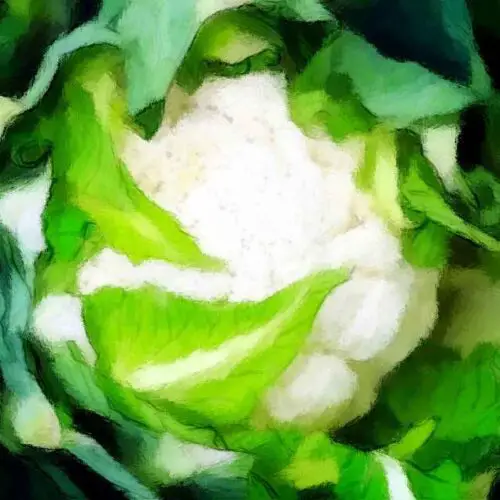
Cauliflower Leaves Kimchi
Ingredients
- cauliflower leaves with stems
- 3 medium sized carrots
- 2 small radishes
- 3-4 green onions
- 1 tablespoon of Korean gochugaru or any other chilli type you like
- 1 tablespoon grated ginger
- 3-4 cloves garlic minced
- 2 tablespoons fish sauce or soy sauce for a vegetarian version
- 1 ½ tablespoons of coarse sea salt 20-25 grams + ½ cup more
- 1 teaspoon salt 5 grams
- 1 tablespoon sesame oil 15 millilitres
Instructions
- Clean, wash and trim the cauliflower leaves, removing all imperfections and those stems that are just to hard to eat
- Depending on your preference leave them in big pieces (even whole if you like) or cut them into bite-sized pieces
- Cover the bottom of a deep tray with one layer of leaves and sprinkle some salt on each one (use the extra half cup of salt for this)
- Continue by layering leaves sprinkled in salt until you run out.
- Let them sit until the stem have become more flexible or even bendable
- Wash carrots, radishes and green onions then proceed with julienning the carrots, slicing the radishes and chopping the green onions
- In a large bowl, combine red pepper flakes, grated ginger, minced garlic, fish sauce (or soy sauce for a vegetarian version), sugar, salt, and sesame oil. Mix well to form a smooth, well mixed paste.
- → If the paste is too thick add a little water
- Remove the cauliflower leaves from their salty bed and wash them
- To the same large bowl add cauliflower leaves, julienned carrot and chopped green onions then WITH GLOVES mix everything thoroughly until all leaves are well-coated with the paste
- Now it’s time to tightly pack the jars with your kimchi mixture
- Make sure to press down the produce enough to eliminate air pockets and to leave enough head space ( 3cm / 1 inch )
- Seal the jars and let them ferment at room temperature for anything between 5 days and two weeks depending on your taste preferences
- When your cauliflower leaves kimchi has reached a flavour you like it’s time to move it to the refrigerator for storage

